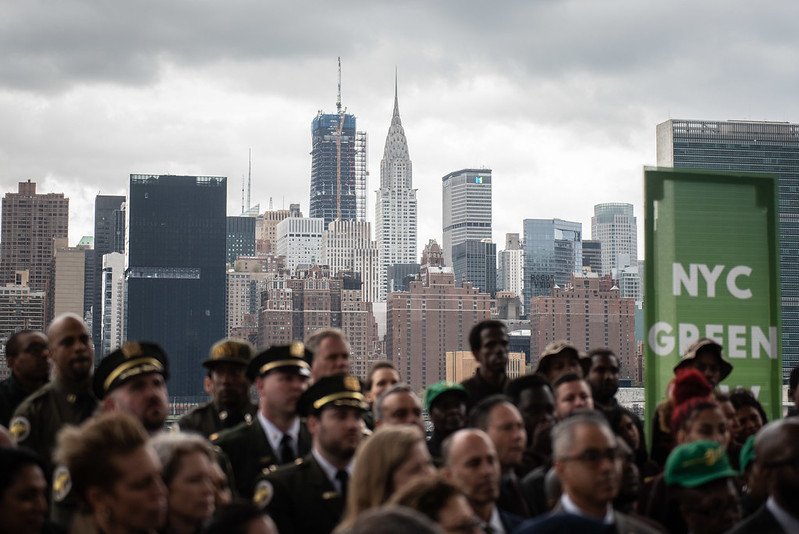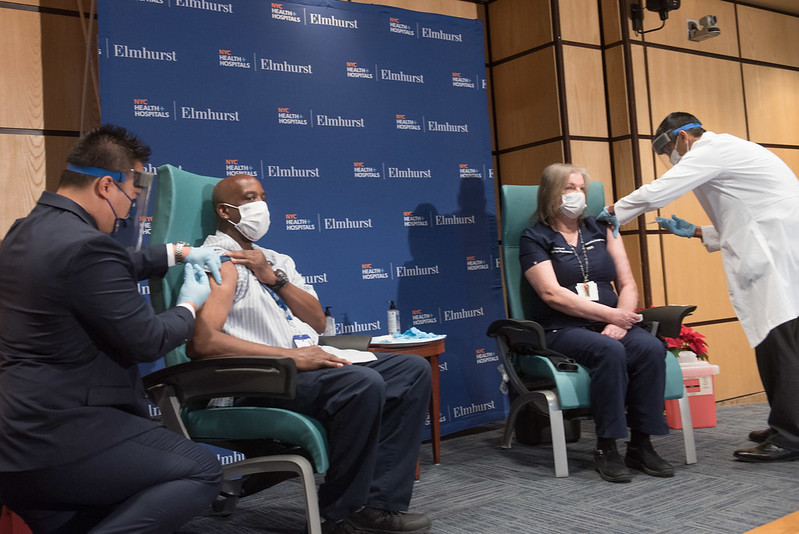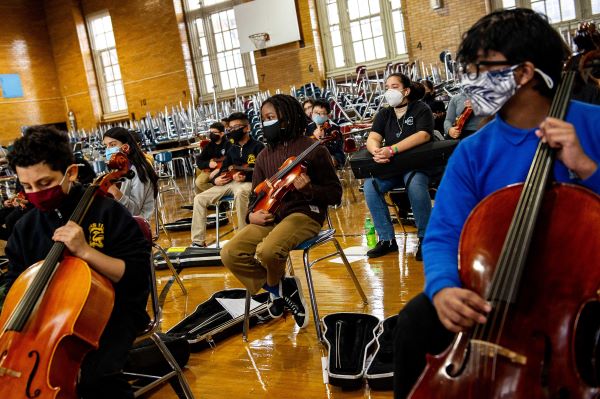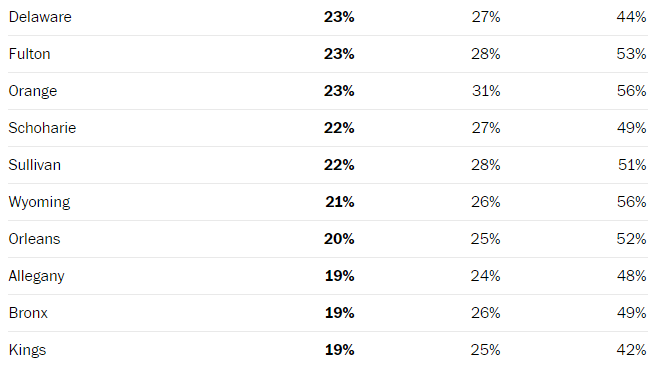Jumpstarting New York’s Green Building Boom

Greening buildings (photo: Michael Appleton/Mayoral Photography)
In 2019, the City Council and Mayor de Blasio passed into law one of the most ambitious pieces of climate change legislation in the country. Local Law 97 will impact 57,000 buildings across the city, with the goal of reducing citywide emissions by 40% by 2030. This is great news for the environment -- commercial and institutional building emissions are the second largest source of carbon emissions in the city, equal to the entire transportation sector. However, if you’re a commercial real estate owner looking at the need to retrofit your entire building, you’re looking at a pretty hefty bill to comply.
At the moment, real estate owners will need to put up about $20 billion for Local Law 97 to be successful. For context, last year they spent about a quarter of a million dollars on these types of projects. And, while there are some financing programs available to help with energy efficiency upgrades, the city needs to provide significantly more upfront funding for the law to succeed. If elected the next City Comptroller, I’ll work to fix that -- and improve the city’s ability to deliver more services to its residents -- by instructing the Bureau of Public Finance to issue at least $10 billion in new financing and bring the city that much closer to reaching its carbon emission reduction goals.
Social Impact Bonds are bonds that pay out interest and principal based on savings accrued through measures that have social benefit. Basically, they pay for success. In the case of Local Law 97, the Bureau would issue bonds, with proceeds of those sales directed to local green banks, like the NYC Energy Efficiency Corporation, or other nonprofit entities tasked with providing Property Assessed Clean Energy (“PACE”) financing to building owners to retrofit their buildings. One of the best case studies for investing in energy efficiency is the Empire State Building, which spent $30 million on energy efficiencies retrofits. It’s saved the building $4.5 million a year and will pay for itself within 10 years. Over 30 years, this $30 million investment will have saved over $135 million. But $30 million is a lot of money, and few will have that sort of up-front capital.
Making social impact bonds available for these activities could significantly improve how many owners comply with Local Law 97, ultimately helping to create more union retrofitting jobs for New Yorkers, pump demand for related work, and put us on track to meet our environmental goals. That’s a big win-win-win. With the right outreach, issuing these bonds could also help address a major deficit of the law -- it does little to promote financing of energy efficiency retrofits in buildings below 50,000 square feet. How many jobs could this create in total? Urban Green Council estimates that retrofits for commercial and residential buildings would create 141,000 jobs by 2030. I would work hard to ensure as many of these as possible are at minority- or women-owned businesses.
Energy efficiency isn’t the only place these bonds could be used. Social impact bonds can be used to reduce recidivism, address homelessness, even help create workforce programs. They help combat perverse incentive structures by ensuring that we pay for results.
This all might sound wonky, but the impact on people’s lives is real. Cleaner air, more good quality jobs for residents, more homeless people helped into homes. COVID-19 devastated the city’s budget and caused the largest economic downturn in living memory. The moment demands more from the city’s elected leaders. It demands we think creatively about how to provide better services while spending less money. As your next Comptroller, I’ll be looking for every way I can use the office to lead the city’s recovery from COVID and make sure that our city residents, not special interests, get the services they need. Social Impact Bonds are a big way we can do that.
***
Zach Iscol is a Democratic candidate for New York City Comptroller. On Twitter @zachiscol.
***
Have an op-ed idea or submission for Gotham Gazette? Email This email address is being protected from spambots. You need JavaScript enabled to view it.
Brooklyn and Bronx Covid Vaccination Rates Worst in State; Black and Latino Vaccination Rates Lag Far Behind

Vaccinations (photo: Michael Appleton/Mayoral Photography Office)
[Note: the vaccine numbers change every day; the data in the article reflect Federal, New York State, and New York City numbers as of April 17, 2021.]
The three counties in New York State with the lowest rate of residents fully vaccinated -- at 19% -- are Brooklyn, the Bronx, and Allegany County (pop. 46,000). This is the broadest measure of the population, everyone age 0 and up. There are 62 counties in the State. Brooklyn also has the lowest percentage of residents age 65 and up fully vaccinated in the entire State, at 42%.
The data are taken from a Washington Post table from April 17, with the source cited as the Center for Disease Control. Here are the ten counties in New York with the lowest rates of residents fully vaccinated.
The left number is % of all residents; the middle number is % age 18 and up; the right number is % age 65 and up:
It has already been widely reported that vaccination rates for Black and Latinos residents of New York City have lagged behind rates for white and Asians residents. The status of New York City’s vaccination rates as of April 17, taken from the New York City Department of Health vaccination tracker, shows key disparities. The criteria for vaccination differs from the above table; here the rates are for persons who have had at least one dose, age 18 and up. 46% of all New York City residents in this category have received at least one dose, but rates vary widely by demographic groups and by borough:
The current data show that vaccination rates for Black and Latino New Yorkers are far behind white and Asian city residents. The percentage of Black New Yorkers aged 18 and up who have at least one dose is 25%; for Latinos, 29%; for whites, 43%; and for Asians, 55%.
Rates for at least one dose among Bronx and Brooklyn residents, at 39% and 41%, respectively, also lag behind the rest of the city, compared to 47% each for Queens and Staten Island, and 56% for Manhattan. Among older residents, Brooklyn once again has the lowest vaccination rate for persons with one dose, at 59% for persons age 65-74, compared to 67% citywide and 75% in Manhattan.
CDC’s COVID-19 vaccine tracker, as of April 17, shows the following:
|
At Least One Dose |
Fully Vaccinated |
||
|
Persons Vaccinated |
129.49 m |
82.47 m |
|
|
% of Total Pop. |
39% |
24.80% |
|
|
Age 18 and Up |
128.3 m |
82.2 m |
|
|
% Age 18 and Up |
49.70% |
31.80% |
|
|
Age 65 and Up |
44.16 m |
35.7 m |
|
|
% Age 65 and Up |
80.70% |
65.30% |
|
For the nation as a whole, 39% of the overall population has received at least one dose; 24.8% are fully vaccinated. For persons 18 and over, 49.7% have received at least one dose, and 31.8% are fully vaccinated. For persons aged 65 and up, nearly 81% have received at least one dose, and 65.3% are fully vaccinated. New York State as a whole is doing better than the nation in the percentage of persons age 16 and up having received at least one dose: 51.5%, compared to 49.7 % nationally, age 18 and up, according to the Washington Post tracker.
New York City and its boroughs also fare poorly compared to vaccination rates across New York State and its regions. This below table, taken from the New York State Department of Health’s vaccine tracker for April 17, shows the percentage of the overall population with one dose, and percentage complete, for the regions, and percentages for one dose for the individual boroughs in the City:
|
NEW YORK STATE VACCINE TRACKER BY REGION |
NYC BY BOROUGH ONE DOSE |
|||||
|
% One Dose |
% Complete |
|||||
|
Statewide |
40.9 |
27.6 |
Kings |
33.5 |
||
|
Capitol Region |
46 |
32.7 |
Queens |
41.4 |
||
|
Cent NY |
43.7 |
31.6 |
Bronx |
30.6 |
||
|
Finger Lakes |
40.9 |
27.6 |
New York |
50.8 |
||
|
Long Island |
43.3 |
29.4 |
Staten Island |
38.6 |
||
|
Mid-Hudson |
42.4 |
28.5 |
||||
|
Mohawk Valley |
37.8 |
28.3 |
||||
|
NYC |
38.8 |
24.9 |
||||
|
North Country |
40.5 |
32.3 |
||||
|
Sthrn Tier |
40.1 |
28.8 |
||||
|
Wester n NY |
41.2 |
28.7 |
||||
The city’s overall vaccination rate lags about two percentage points behind the state’s overall rate ( in which New York City is averaged in), at 38.8% versus 40.9%. The Bronx rate is 30.6%, and Brooklyn is 33.5%, more than ten and more than seven points behind the state overall rate. Only one region of the State, the Mohawk Valley, has a lower overall vaccination rate than New York City.
I am sure that the city and state governments are trying to get the vaccine into the arms of New York residents as quickly as possible, and are making strenuous efforts to reach the minority populations of the state (which combine for a majority in the city). But the stubborn facts presented here show that these efforts to reach the Black and Latino populations, and the elderly populations, are simply not that successful so far.
***
Jim Brennan was a member of the New York State Assembly for 32 years, where he chaired four committees. On Twitter @JimBrennanNY.
***
Have an op-ed idea or submission for Gotham Gazette? Email This email address is being protected from spambots. You need JavaScript enabled to view it.
What New York City’s Education Sector and All Who Care About It Should Take Forward From a Year of Remote Teaching and Learning

Music class (photo: @ETMonline)
Two weeks before schools closed last March, our team at the New York City nonprofit Education Through Music brainstormed ways to provide music lessons online so that students wouldn’t miss a beat. At the time, we didn’t imagine we would be teaching virtually for an entire year. We’ve now hit the one-year mark of online learning, and while the past year has been filled with seemingly insurmountable obstacles, the education sector has risen to the challenge.
Yet many difficulties remain. Our students have faced the trauma of isolation, fear and, in many cases, grief. Racial inequity remains widespread. And although music programs are vital to a well rounded education, over half of New York City public schools don’t have a full-time music educator on staff. Giving students access to music education is core to my nonprofit’s mission and vital to facing these continuing chall enges.
New York City Schools Chancellor Meisha Porter wants to prioritize learning from the lessons of the past year, including continuing to use digital tools. We also need to bring a new mindset going forward. There are three crucial principles we as a city and as education professionals must carry forward from the past year as we rebuild a more just system that serves all students.
Collaboration
To adapt as circumstances change, education organizations must collaborate effectively across teachers, administration, nonprofits, and the Department of Education. When possible, we should also build partnerships beyond educational organizations. We know working with other educators and partners enables us to achieve goals greater than individual organizations can reach separately. Going beyond sector-based partnerships multiplies our potential impact even further.
For example, by collaborating with BronxNet and WNET to provide on-demand lessons via TV, we were able to reach more students than ever, including those who can’t access music education elsewhere. Who else can we work with? Who is speaking to the students we struggle to reach? How can they help us? Educators must continually ask ourselves these questions as we rebuild better systems in the coming years.
Inclusion
The past year has made the public aware of the vast inequities still present in our country and education system. To rebuild in 2021 and beyond, we must foster inclusion in the classroom, schools administration, and through policy decisions, including financial commitments, across the city and state. Studies have shown that diversity in schools is beneficial to students, who are able to learn from one another and broaden their understanding of different cultures. This is equally true of lesson content and we must all push ourselves and our organizations to do more to include diverse perspectives and voices into our curriculum.
The National Association for Music Education explains that including all forms and types of music within the classroom allows students to explore and expand their communication, collaboration, and music literacy skills in a variety of formats, structures, and ensembles. To that end, Education Through Music has reviewed its music repertoire of roughly 2,000 pieces of music to ensure it is diverse and inclusive, and will be taught with cultural contexts, enabling us to share the rich diversity of music with our students. At the same time, we developed social justice resources and training for teachers. And we can do more by connecting music educators to the school community and providing opportunities for parents and the community to participate.
Drive
To promote a system where all voices are celebrated and empowered, we must have high aspirations, day-to-day flexibility, effective partners and a focus on the goal of inclusion. Challenges will always exist, and must not distract us from the bigger picture. In that spirit, Education Through Music launched its first high school music class this year despite the pandemic. As an almost-thirty-year-old organization, this has been a goal for a long time, and the pandemic threatened to jeopardize HS 223 students’ opportunity to experience music class as high schoolers. All parts of the education system must keep that focus on the next place for improvement at all times, even when facing monumental challenges.
Looking forward, I have hope that our students and staff can return to a sense of normalcy, and our teachers can have the in-person engagement with students that our educators crave. I am excited to see our students enjoy the live performance opportunities they’ve missed for more than a year. And I anticipate returning to a kinder society that supports an equitable and inclusive education, and recognizes children’s social and emotional needs.
***
Penny Swift is the Executive Director of Education Through Music. She is a lifelong advocate for equality and excellence in education, a former special education teacher, and a proud alumna of New York City’s public schools. On Twitter @ETMonline.
***
Have an op-ed idea or submission for Gotham Gazette? Email This email address is being protected from spambots. You need JavaScript enabled to view it.






